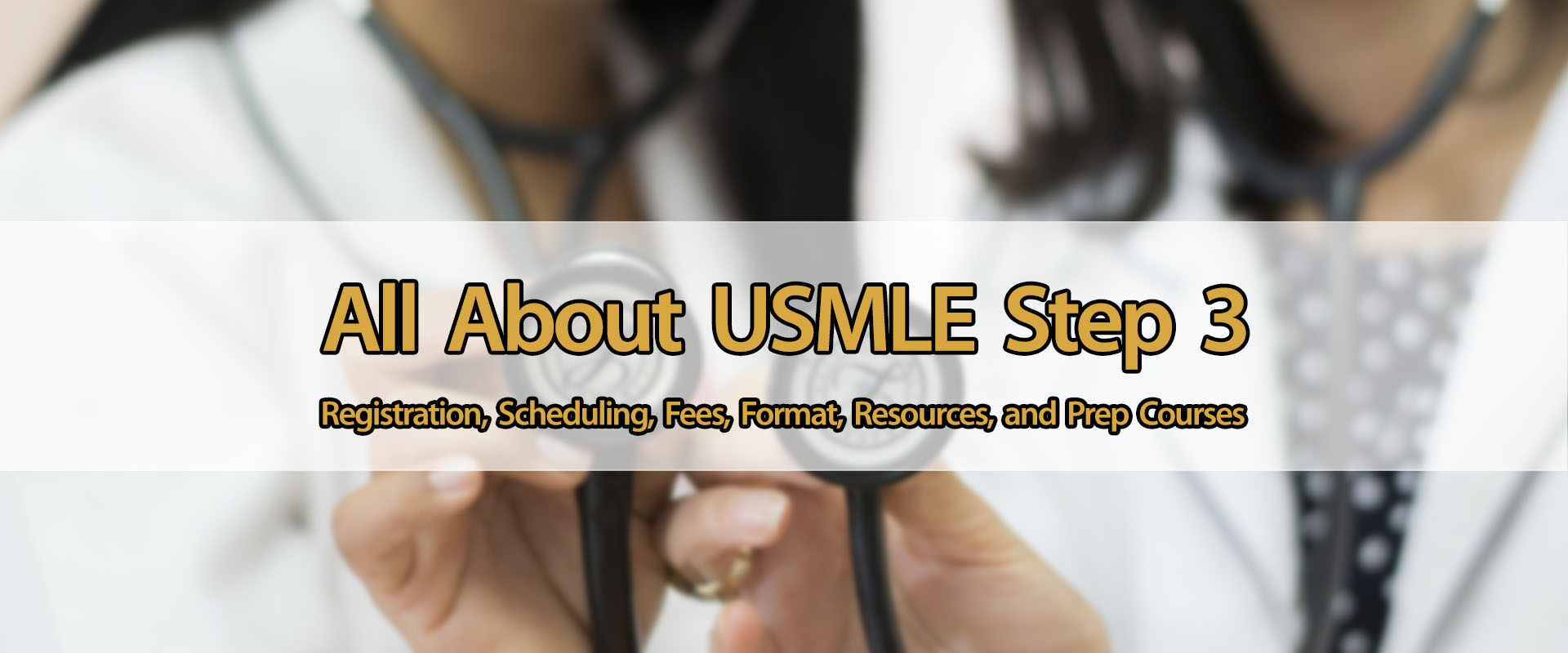USMLE Step 3: Everything You Need to Know
All You Need to Know About USMLE Step 3: Pass Rate, Passing Score, Percentile, Average Score, Study Schedule, Questions, Preparation, Fees, Dates, Registration, Pricing, Scheduling, Registration, Reschedule, Exam Format, CCS, CCS Cases, Tips, Resources, Qbanks, Notes, MCQs, Books, Secrets, Practice Tests, Tutors, Videos, Review Courses, Strategies, Live Classes, Online Sessions, and Best USMLE Step 3 Prep Courses.

Preparing for medical licensing exams can be challenging, especially as you reach the final stretch USMLE Step 3. This exam is the final gatekeeper to your dream of practicing medicine in the United States without supervision. If you’re scratching your head about the ins and outs of this crucial test, you’ve landed on the right page. Here’s your ultimate guide, breaking down everything you need to know.
Table of Contents
- What is USMLE Step 3?
- Who Takes the USMLE Step 3?
- When Should I Take the USMLE Step 3?
- What’s on the Exam?
- How to Apply for the Step 3 Exam?
- Fees for USMLE Step 3
- Where Can I Take the Step 3 Exam?
- How to Excel in Step 3
- USMLE Step 3 Prep Courses
- How Can I Make Sure I’m Prepared?
- Exam Pattern and Syllabus
- How is USMLE Step 3 Scored?
- Tips to Prepare for USMLE Step 3
- FAQs
What is USMLE Step 3?
USMLE Step 3 acts as the terminal juncture in the USMLE series, aiming to fully evaluate a medical graduate’s ability to manage patient care, particularly in outpatient settings, independently. Crafted by committees of medical experts—comprising academics, practicing physicians, and state medical board members—the test integrates a spectrum of clinical situations, simulating the experiences that a physician new to unsupervised practice might encounter.
Content Overview
Step 3 incorporates a data-driven representation of generalist medical practice in the United States. Its content is tailored to simulate clinical scenarios one might find in varying medical settings, serving as a definitive appraisal of a physician’s readiness for independent practice. The exam is structured over two days, each with a unique focus: the first day targets the Foundations of Independent Practice (FIP), and the second focuses on Advanced Clinical Medicine (ACM).
Exam Format
This two-day examination comprises multiple-choice questions (MCQs) and computer-based case simulations. The first day allocates about seven hours for 232 MCQs, divided into 6 blocks of 38-39 questions each, with a 60-minute time frame for each block. Additionally, 45 minutes are designated for breaks and a 5-minute optional tutorial. The second day expands to approximately nine hours and features 180 MCQs, sorted into 6 blocks of 30 questions each. This is accompanied by a 7-minute tutorial on computer-based case simulations, followed by 13 such case simulations.
Day 1: Foundations of Independent Practice (FIP)
The primary objective of this testing day is to assess a candidate’s grounding in the basic medical and scientific principles vital for effective healthcare delivery. This includes mastering foundational sciences and understanding biostatistics, epidemiology, population health, and the ability to interpret medical literature. Social sciences like communication skills, medical ethics, and systems-based practice are also examined. This day is exclusive to MCQs but employs varied item formats, such as questions rooted in scientific abstracts and pharmaceutical ads.
Day 2: Advanced Clinical Medicine (ACM)
The second day focuses on evaluating a candidate’s proficiency in applying broad-spectrum knowledge concerning health and disease, particularly regarding patient management and disease evolution over time. This involves gauging your prognosis and outcome analysis skills, health maintenance, therapeutic strategies, and medical decision-making. Like the first day, the assessment extends to history-taking, physical examination skills, and diagnostic studies. This day combines MCQs with computer-based case simulations, providing a rounded view of a candidate’s clinical acumen.
The USMLE Step 3 CCS, however, are digitized versions of patient encounters designed to evaluate your decision-making skills in a simulated real-world environment. From collecting the medical history and conducting a physical exam to ordering tests and devising a management plan, CCS allows you to showcase your clinical competence. Importantly, CCS highlights your efficiency, patient management skills, and ability to handle complications. They simulate real-time challenges and expect you to act just as you would in a clinical setting.
Who Takes the USMLE Step 3?
The USMLE Step 3 is typically considered a step for those well into their postgraduate training. In other words, medical graduates in their residencies often undertake this exam. Being actively engaged in a clinical setting helps you make the most out of Step 3 preparation and, subsequently, the examination itself. The application for this exam is facilitated through the Federation of State Medical Boards (FSMB) website, making it accessible to medical graduates irrespective of their country of study.
However, foreign medical graduates have an additional set of criteria to fulfill. If you’ve graduated from a medical school outside the U.S. and Canada, your school must be listed in the World Directory of Medical Schools and satisfy the ECFMG eligibility conditions. These stipulations ensure a minimum standard is met, irrespective of where your medical journey began. This inclusivity ensures that the USMLE Step 3 is a universal metric to evaluate the capability of all medical graduates aiming to practice in the United States.
When Should I Take the USMLE Step 3?
Deciding when to take the USMLE Step 3 is critical and is primarily guided by where you are in your postgraduate journey. The USMLE program recommends that you undertake Step 3 after completing or nearing completion of at least one year in a U.S.-accredited residency program. This first postgraduate year typically offers the hands-on clinical experience needed to ace the Step 3 examination. The more clinical experience you have, the better prepared you’ll be for the complex scenarios presented in the CCS part of the exam.
Timing also plays a significant role, especially if you’re juggling residency duties. The busiest months for Step 3 testing are May through July and November through December. With test slots being allocated on a first-come, first-served basis, scheduling your exam well in advance is beneficial. Planning ensures you get your desired test date and allows some wiggle room should you need to reschedule due to unforeseen circumstances.
What’s on the Exam?
The USMLE Step 3 is structured as a two-day computerized test with approximately 500 MCQs and Computer-based Case Simulations (CCS). The MCQs cover a broad range of topics, primarily focusing on patient management, taking up 45-55% of the questions. Other areas include history and physical, lab and diagnostic studies, diagnosis, prognosis, and pathophysiology, each accounting for about 8-12% of the exam questions. The CCS portion puts you in charge of digital patient encounters, evaluating your capability to manage cases effectively, from initial diagnosis to treatment plans.
Day 1 of the exam is called the Foundations of Independent Practice (FIP), which takes approximately seven hours to complete. It features 233 MCQs divided into 6 blocks of 38-40 items each. Day 2, known as Advanced Clinical Medicine (ACM), lasts about nine hours and features 180 MCQs and 13 CCS scenarios. The CCS scenarios include a seven-minute tutorial to acclimate you to the software. Planning your approach to each section can significantly influence your performance on this final and crucial exam.
How to Apply for the USMLE Step 3 Exam?
Registering for the USMLE Step 3 isn’t just about picking a date and showing up; it’s a carefully structured process that verifies your qualifications at each step. The first box to tick is ensuring you meet the eligibility requirements. These prerequisites encompass having an M.D. or D.O. degree and successfully clearing the USMLE Step 1 and Step 2 exams, including the Clinical Knowledge and Clinical Skills sections. A certification from the Educational Commission for Foreign Medical Graduates (ECFMG) is mandatory for international medical graduates. It’s crucial to note that using a Fifth Pathway certificate as a qualification was valid only until the end of 2016.
The procedural wheel is set in motion with an online application on the Federation of State Medical Boards (FSMB) website. Here, you’ll have to upload proofs of your educational and test qualifications and shell out an application fee of $830 through an approved credit card. Other essentials include a notarized Certification of Identity (CID) form with a photo and an email address for correspondence. The application also requires you to choose a three-month window in which you plan to take the exam. Once all these pieces fall into place, FSMB will issue a scheduling permit for your golden ticket to book your exam date at a Prometric testing center.
Additional Tips and Information
Remember that any changes may incur an extra fee upon setting your test date. If you can’t make it within your initially chosen three-month eligibility period, extensions are available at an additional cost of $70. Retaking the exam? You’re allowed three retakes within a year but must wait 6 months after the third try before attempting again. Further retakes must be spaced at least a year from your first attempt.
Don’t step into the arena unprepared. Familiarize yourself with the structure and content of the exam to strategize your study plan effectively. The first exam day alone consists of approximately 260 multiple-choice questions and lasts seven hours. The second day includes 13 case simulations and 180 multiple-choice questions within nine hours, so a thorough preparation strategy is non-negotiable.
Fees for USMLE Step 3
Navigating the financial aspect of taking the USMLE Step 3 is as important as understanding the exam’s format and content. As of 2023, the FSMB registration fee for a scheduling permit is $915. It’s crucial to note that this fee is non-refundable and non-transferable. This fee covers a 3-month eligibility period, so planning your study schedule around this timeframe becomes vital to your exam preparation. Make sure to factor this cost into your overall budget for the Step 3 experience, as it’s a significant financial commitment.
The financial considerations continue after the initial payment. If you need to reschedule your exam date(s), doing so less than 46 days before your scheduled date will incur additional fees, the specifics of which are outlined on the USMLE site. As life is unpredictable, rescheduling is sometimes unavoidable, but knowing the associated costs will allow you to make more informed decisions. Consider your clinical commitments, personal obligations, and study plan before finalizing your exam date to avoid unnecessary rescheduling fees.
Budgeting for Step 3 goes beyond just the examination fee. It should ideally include the cost of prep courses, study materials, and possibly even travel and accommodation if your chosen Prometric® center isn’t nearby. Remember these financial factors as you plan and prepare for this crucial exam.
Where Can I Take the Step 3 Exam?
After accepting your application, you can schedule your USMLE Step 3 exam at a Prometric® test center. The test centers are available throughout the United States and its territories, offering considerable flexibility when choosing a location. It’s advisable to book your slot well in advance, as test centers often fill up quickly, especially during peak testing times like May through July and November through December.
The Prometric® centers are designed to provide a controlled, proctored environment to ensure the integrity of the exam. These centers have all the technology needed to administer the test effectively. And, because life happens, they usually allow rescheduling, although you may incur a fee. So, plan and aim for a test center that suits your location, comfort, and availability needs.
How to Excel in Step 3
To excel in USMLE Step 3, your preparation should blend theoretical knowledge and practical application. A well-structured study plan is a must, incorporating a variety of resources such as books, journals, and question banks. Focus on mastering topics like patient management, as they make up a significant portion of the exam. Utilize online platforms and mobile apps that offer practice questions and simulated exams to get a real-time feel of the test.
The Computer-based Case Simulations (CCS) deserve special attention. This segment tests your ability to manage patient encounters from start to finish, and it’s an area where even seasoned professionals can trip up. Familiarize yourself with the software used in the exam to avoid any technical hiccups on the big day. Run through multiple simulated scenarios to practice making timely and accurate clinical decisions. Both these aspects will significantly boost your confidence and performance on the exam.
USMLE Step 3 Prep Courses
The market is flooded with various USMLE Step 3 prep courses, each promising to be the definitive guide to cracking the exam. When choosing a prep course, consider factors like course structure, quality of the faculty, and student reviews. Many courses offer learning tools, including videos, webinars, practice questions, and one-on-one tutoring.
Opt for a course that aligns well with your learning style and schedule, especially if you’re in the middle of your residency. Also, consider the prep course’s focus on Computer-based Case Simulations, as that’s a crucial part of Step 3. Given that you are investing time and money ensure you get comprehensive, up-to-date, and effective prep material. Some popular names in this space include Gold USMLE Review, Kaplan, UWorld, and Archer Review.
How Can I Make Sure I’m Prepared?
Preparation for USMLE Step 3 is not just about hitting the books; it’s also about strategic planning and effective execution. Start by assessing your strengths and weaknesses early on, possibly through a practice test. This allows you to focus your study time on areas that need improvement. Maintain a steady studying pace, creating a realistic and achievable study schedule incorporating time for review and relaxation.
Mock exams are invaluable. They gauge your readiness and help you get accustomed to the test format and timing. Monitoring your scores in these practice tests can provide real-time feedback on your preparation level. As a resident, finding the time to study can be challenging. However, consistent effort and efficient use of available resources can significantly affect your readiness and, eventually, your score.
This wraps up our extensive guide on USMLE Step 3. Whether you are at the beginning of your Step 3 journey or near the end, we hope this blog post is helpful for your exam preparation.
Step 3 Exam Format and Pattern
The USMLE Step 3 is no ordinary test. Designed to simulate the myriad challenges and responsibilities that general physicians must navigate, the exam measures your readiness for unsupervised medical practice. This ambition shines through its comprehensive two-day format, which serves as the final hurdle in your journey toward medical licensure.
Day One: Foundations of Independent Practice
- Duration: 7 hours total, including 45 minutes of scheduled break time and a 5-minute optional tutorial.
- Format: 232 Multiple-Choice Questions (MCQs) divided into 6 blocks, each containing 38 to 39 questions.
- Time Allotment: You have 60 minutes to complete each block.
Day one zeroes in on the Foundations of Independent Practice. You will encounter a range of questions that test your medical knowledge and understanding of the underlying principles of medical science.
Day Two: Advanced Clinical Medicine
- Duration: 9 hours, including a 45-minute break and a 5-minute optional tutorial.
- Format: 180 MCQs divided into 6 blocks, each featuring 30 questions.
- Special Features:
- 7-minute Computer-based Case Simulations (CCS) tutorial.
- 13 case simulations, each allocated between 10 to 20 minutes.
Day two elevates the complexity by focusing on Advanced Clinical Medicine. This includes intricate case simulations designed to emulate real-world patient scenarios. There might also be an optional survey, depending on the time availability.
USMLE Step 3 Syllabus
Your study material is free of a few chapters or sections. Instead, the syllabus covers 18 major areas in the integrated content outline. A quick snapshot of some subjects you’ll tackle includes:
- General Principles of Foundational Science
- Immune System, Blood & Lymphoreticular System, and Multisystem Processes/Disorders
- Behavioral Health
- Nervous System & Special Senses
- Musculoskeletal System
- Cardiovascular System
- Patient Care: Diagnosis and Management
- Systems-based Practice/Patient Safety and Practice-based Learning
The USMLE Step 3 is the culmination of years of rigorous medical training, designed to gauge whether you’re truly ready for the next big step: practicing medicine without supervision. Know the structure, familiarize yourself with the syllabus, and you’ll not just pass—you’ll excel.
How is USMLE Step 3 Scored?
If the road to taking the USMLE Step 3 feels like a marathon, then understanding how it’s scored is like knowing the rules of the race. After the two-day test, candidates can expect their results within two to four weeks. The score report will primarily have two sections: a pass/fail status and a three-digit score that gives a more nuanced understanding of your performance. The maximum score on this test is capped at 300, setting the bar for excellence.
Unlike your high school or undergraduate exams, where the passing marks might have been set in stone, the USMLE Step 3 has a minimum passing score that fluctuates. The examination committee determines this variability and changes over time. However, a helpful ballpark figure to remember is that you’ll likely need to answer around 60% of the questions correctly to pass. And remember to consider the case simulations; they’re a significant part of the assessment criteria. Your performance in these simulations can heavily influence your overall score, turning them into potential game-changers for your medical career.
Tips to Prepare for USMLE Step 3
Approaching the USMLE Step 3 without a clear game plan is like venturing into a labyrinth blindfolded. The complexity of this two-day exam, featuring a mix of multiple-choice questions (MCQs) and computer-based case simulations, demands meticulous planning. Begin by laying out an organized timeline to tackle critical topics well before the exam date. Take the time to analyze the percentage weightage assigned to each subject area; this can help you prioritize topics that will yield the most points on the exam. However, Step 3 isn’t just a theoretical playground; it evaluates your readiness to apply medical knowledge in practical situations.
In today’s digital age, leverage the plethora of resources available online. Several platforms offer practice tests and sample questions complete with detailed explanations, enabling you to grasp the nuances of the topics covered. But don’t limit yourself to MCQs. Given the importance of case simulations in Step 3, practicing them online is non-negotiable. Engaging with these digital case studies will deepen your understanding of clinical scenarios and help you get the hang of the test’s format. These practical exercises focus on honing your clinical reasoning skills, equipping you with the necessary tools to ace the USMLE Step 3. So, ditch the last-minute cramming and embrace a balanced, comprehensive approach to test preparation.



